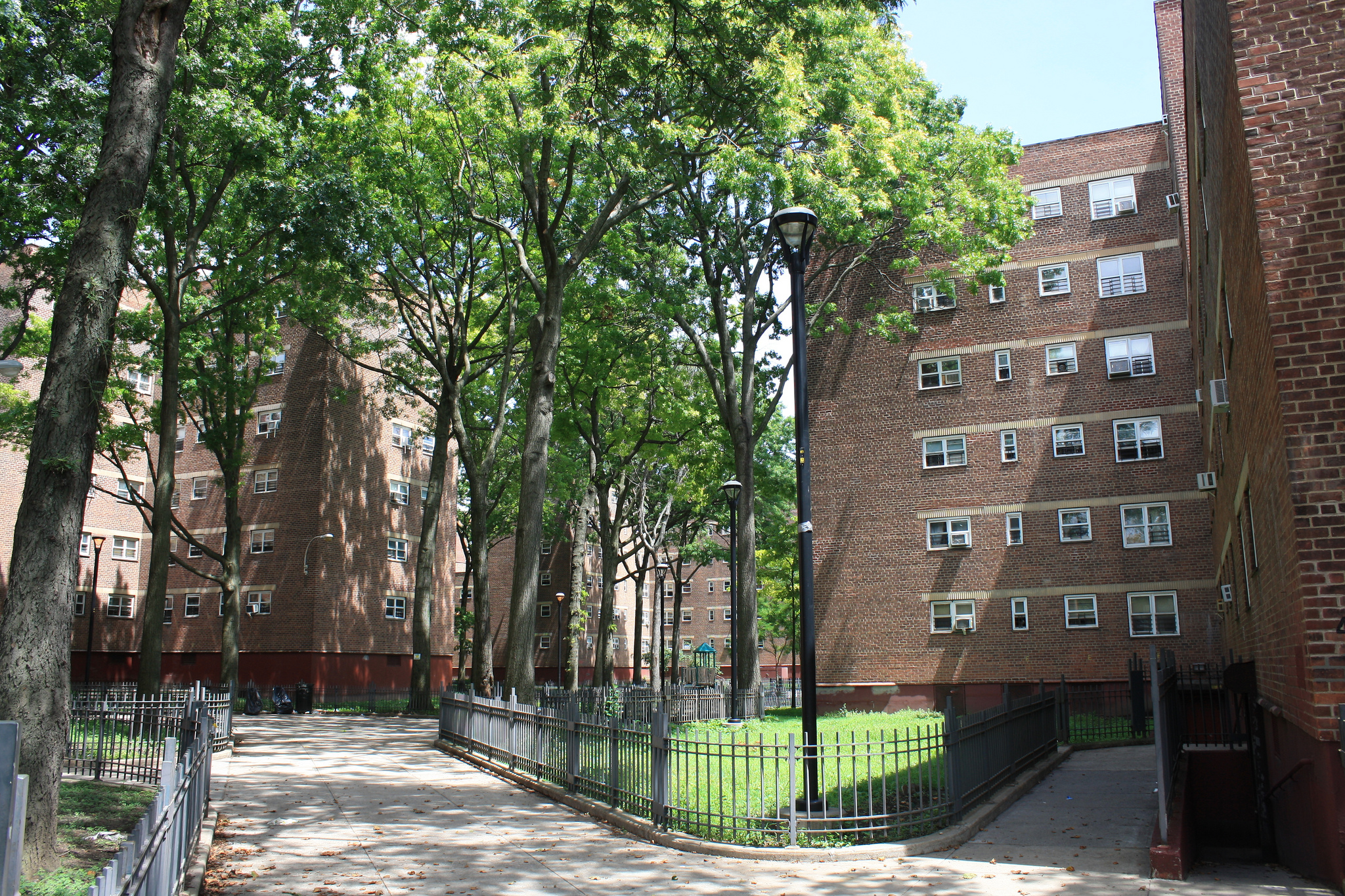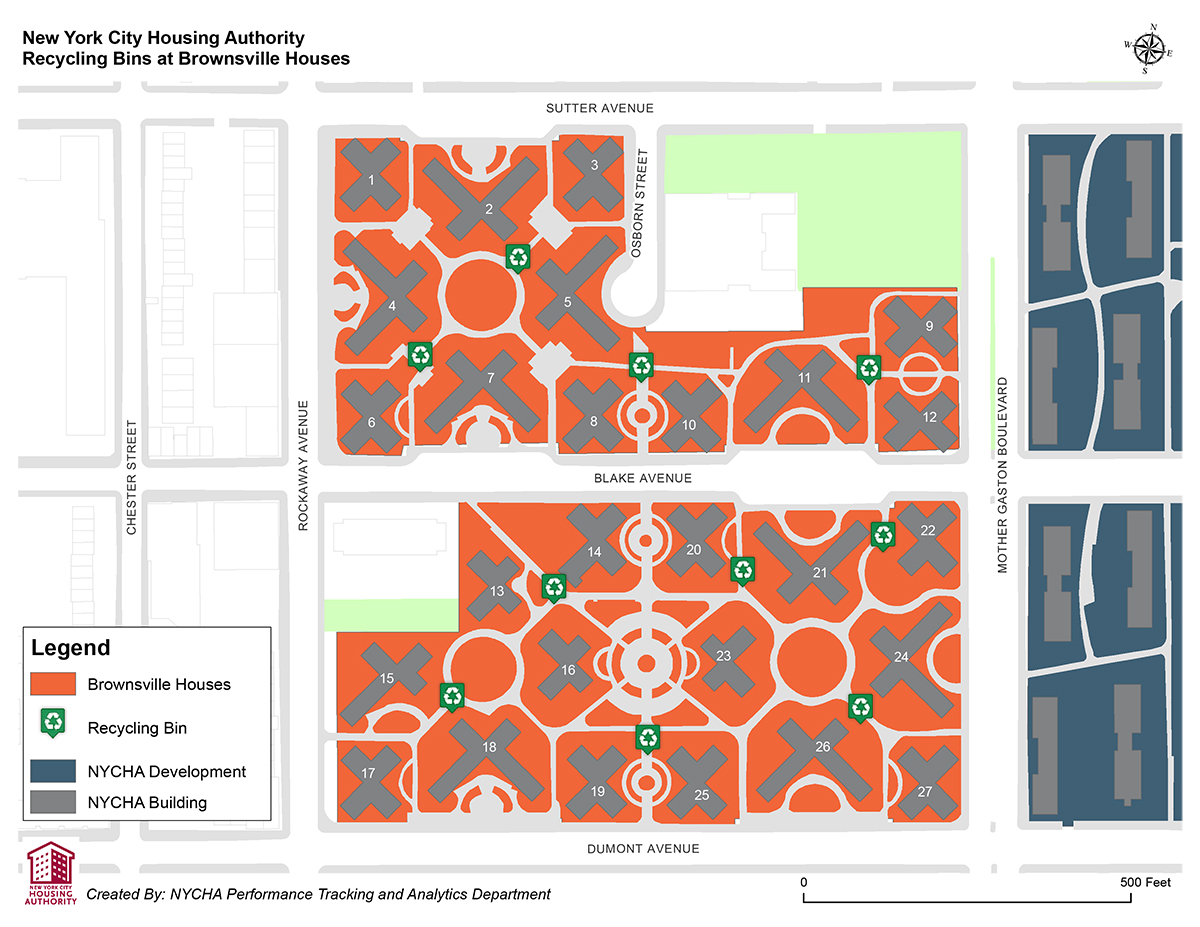Information about the Challenge
 Photo Credit: Phillip Pantuso
Photo Credit: Phillip Pantuso
Pilot Site
Brownsville Houses, operated by the New York City Housing Authority, is a large residential development housing more than 1300 families in the neighborhood of Brownsville, Brooklyn.
The development was chosen because it displays many of the waste system patterns that other NYCHA developments are struggling with and for its potential to be at the vanguard of the movement to ‘clean and green’ public housing. At Brownsville Houses, young environmental ambassadors are working with residents and teens to create a shared vision of sustainability, while the strong leadership of the Brownsville Houses Tenants Association is successfully advocating for transformative capital investments, including a brand new community cultural center.
With a dense cluster of low-rise buildings over two super-block campuses, the built environment of Brownsville Houses represents a common typology across the NYCHA portfolio of developments, meaning that technologies that prove their value at Brownsville Houses can scale to other developments.
Demographics of Brownsville Houses*
1,317 families
3,278 population
1,084 female head of household
2.5 average family size
30% minors under 18
12% population 62 years plus
27 % families with head 62 and over
$21,752 average gross income
19% families using welfare
22 average years in public housing
(*as of 1 Jan 2017)
Waste and Recycling at Brownsville Houses
Brownsville Houses has nine double recycling stations and one single recycling station set up around the campus. In each station, residents can put metal, glass, plastic, and cartons into the blue bin; residents can place paper and cardboard in the green bin.
Each day, NYCHA maintenance caretakers remove the bags of recyclables and store them for once-a-week curbside collection by DSNY. On average, DSNY has collected fewer than twenty bags of recyclables total per week from Brownsville Houses. Although Brownsville is currently one of the more active NYCHA recyclers, based on the waste composition and number of households, Brownsville Houses could divert hundreds more of bags worth of recyclables from their landfill trash per week.
Recycling Stations
Brownsville Houses, like most NYCHA developments throughout the city, has relatively new recycling bins located throughout the campus (approximately 1 for every 3 buildings) that are regularly serviced by NYCHA staff. Custom chute decals and other information resources are distributed throughout the development to raise awareness about the new system.

Installation of Tech Solutions at Brownsville Houses
Participants may consider a variety of approaches that will most effectively support their solution, and propose the infrastructure necessary to enable it.
About physical installations
- Installations will be temporary (4-12 months, as determined by NYCHA and DSNY, in consultation with the solution provider);
- Installations must follow basic siting guidelines as determined by NYCHA;
Availability of digital kiosks Participants may consider proposing solutions that can be activated with equipment that is being made available for this challenge:
- EnviroKiosk (2 are available)
- Presenza Kiosk (2 are available)
In the application, please detail how your team would propose to deploy this hardware if you choose to use it.
Several reports and studies provide useful information about the nature of the waste problem at NYCHA developments. We have highlighted a few summarized insights from each report.
- Improper disposal of trash: NYCHA public housing residents dispose of most of their household trash by throwing it down a 9 inch by 9 inch chutes located in the hallway on each floor. Because these chutes are very small, residents often fail to successfully put their garbage inside them. As there are often no good places to bring trash that does not fit down the chute, residents end up leaving trash bags in the hallway or inappropriate locations throughout the grounds. Informal disposal points quickly become disorganized and messy, and lead to increased litter throughout the grounds.
- Contaminated recycling: Recycling bins become some of the only formal places around the grounds to put trash, which lead to frequent contamination of the recyclable materials. When caretakers choose to simply throw out the contaminated recycling as trash, it makes the waste management process go faster, but it decreases NYCHA’s recycling diversion rate.
- Time spent on trash: Collecting, sorting and transporting trash takes up a large portion of NYCHA caretakers’ days. Research shows that it occupies about 50% to 60% of their time. The biggest challenge for caretakers involves residents improperly disposing of trash.
NYCHA Waste Stream Analyses - October 2017 Technical Memorandum
-
Recycling inefficiencies
- In the Metal/Glass/Plastics (MGP) bin, 21% is properly placed recyclables, 44% is improperly placed paper or cardboard, and 35% of the material is landfill waste.
- In the Paper/Cardboard bin, 59% is properly placed recyclables, 12% is improperly placed MGP, and 30% of the material is landfill waste.
- The success of the recycling bin program is highly dependent on each building’s investment in the program. Even within one development, recycling bin efficiency can vary greatly from one bin to the next, meaning bin maintenance procedures for NYCHA staff must be altered for certain locations.
-
Missed opportunities with bulk waste
- Accumulation of bulk waste attracts a variety of pests, such as bed bugs and rats. Bulk waste made predominately of fabric (such as mattresses and upholstered) is at a particularly high risk of attracting bed bugs. This may pose a threat to maintenance staff and sanitation workers who then encounter the infested bulk waste.
- Developments need improved bulk waste management, particularly bulk compactors.
- On average, more than 14% of bulk waste was identified as ‘recyclables’, primarily cardboard. DSNY has reported an exponential increase of cardboard in the waste stream since the popularization of online shipping.
- NYCHA can significantly increase their diversion by installing bulk recycling bins. Significant quantities of unwanted but usable large items are sent to landfills each month. While there are opportunities in NYC to donate these items, it is difficult and time intensive to transport them to drop‐off locations. NYCHA residents instead often opt to throw away their usable bulk waste.
- On average, 65% by volume of waste in the bulk containers consists of furniture.
-
Improper disposal and illegal dumping by non-residents
- Despite warning signage and “no dumping” notices along the perimeter of housing sites, many NYCHA developments are victim to non-residents or businesses disposing of waste on the campus, particularly at night when there are fewer staff and security precautions are limited.
- Waste from non-residents currently accounts for approximately 15% of the bulk waste removed from NYCHA Developments that reported improper disposal or illegal dumping by non-residents, and contributes to logistical difficulties of keeping the grounds clean and rodent free.
-
Other resource materials:
- Zero Waste Design Guidelines
- Next-Generation NYCHA Plan
Funding Available
The selected team(s) will be eligible for up to $20,000 in funding. A preliminary outline of funding needs must be detailed in the application. Funds can be used for equipment purchase and installation, as well as expenses related to insurance, maintenance, user testing, and evaluation.
Evaluation Criteria
Solutions will be evaluated by their potential to achieve one or more of the following goals at the designated site:
- increase capture rate – % of total paper, metal, glass, plastic, and organics in the waste stream that is disposed of by recycling or composting (w/minimal contamination rate)
- reduce visible litter on the streets and common areas
- reduce # of hours that NYCHA caretakers spend managing waste
- reduce # of NYCHA work orders associated with trash and litter in common areas
- increase # of residents engaging with waste systems
- increase residents’ perceptions of cleanliness
- generate opportunities in the neighborhood and involve community members in the design
- implementation, operation, and evaluation of the solution
We are in the process of working with community partners, our City agency partners, and NYU CUSP to establish a quantitative baseline of the site. We will evaluate the tests against this baseline. We will work with selected technology providers to develop success metrics tailored to individual solutions.
Additionally, solutions should:
- Be scalable, demonstrate usability for multiple sites, and have a cost model that leverages NYCHA’s economies of scale
- Be minimally invasive, have long life spans with low operation, maintenance, and installation requirements;
- Consider how the experience can be accessible to all users, including those without smartphones or data plans;
Solutions must also follow the NYC IoT Guidelines.
Evaluation Panel
- Bridget Anderson, DSNY, Deputy Commissioner, Recycling and Sustainability
- Monika Wysocki, DSNY, Special Assistant to the Commissioner
- Jeremy Neiman, DSNY, Data Scientist
- Jared Cole, DSNY, Senior Manager Recycling Outreach
- Kilsys Payamps-Roure, NYCHA, Chief of Staff to the General Manager
- Brian Clarke, NYCHA, Senior Vice President for Property Management Operations
- Chanel David, NYCHA, Brownsville Property Manager
- Vlada Kenniff, NYCHA, Director of Sustainability
- Rasmia Kirmani-Frye, Fund for Public Housing, President
- Miguel Gamiño Jr., MOCTO, Chief Technology Officer
- Kate Daly, NYC Economic Development Corporation, Senior Vice President, Center for Urban Innovation
- Constantine Kontokosta, NYU Center for Urban Science & Progress, Assistant Professor of Urban Informatics
Succeeding in Brownsville / Best Practices
Successful solutions will be responsive to the following principles, drafted in collaboration with Brownsville Tech Board, who will advise in the selection of proposals.
Empowering: Successful solutions should create and support opportunity and equity in Brownsville
Responsive: Successful solutions should be useful, respond continuously to the needs of the community, and generate significant impact
Accessible: Successful solutions should serve, be inclusive of, and be usable by all members of the community
Transparent: Successful solutions should make their products, processes, outcomes, partners, and participants clear and transparent
Responsible: Successful solutions should be safe and well-maintained
Sustainable: Successful solutions should be environmentally sustainable and support NYC’s Zero Waste and 80x50 missions. They should have a clearly-defined plan for growth, scale, and mechanisms for support
Compliant: Successful solutions should follow NYC IoT Guidelines (on privacy, transparency, infrastructure, data management, security, operations, and sustainability) and all applicable NYC rules and regulations.
